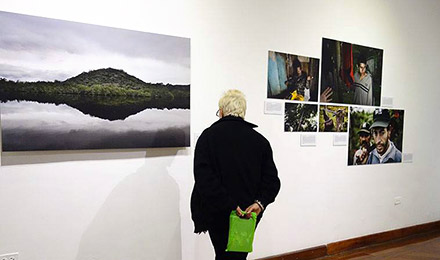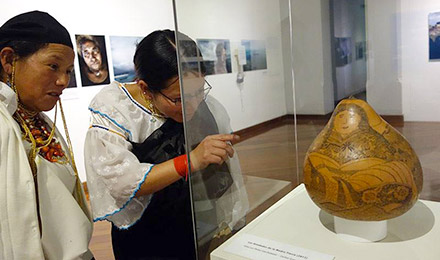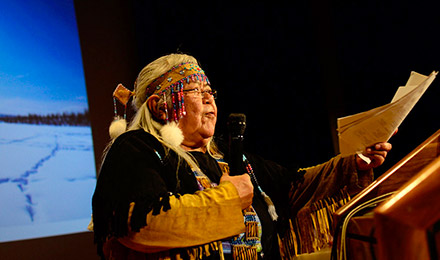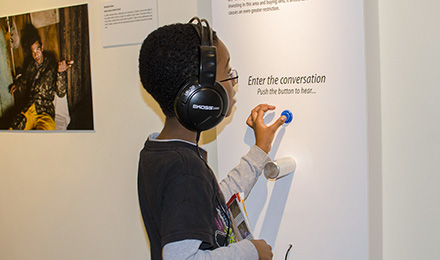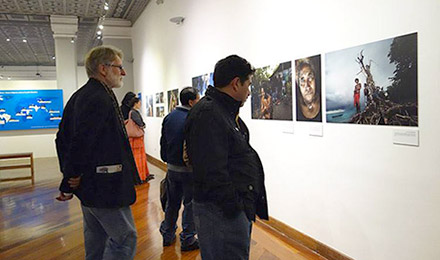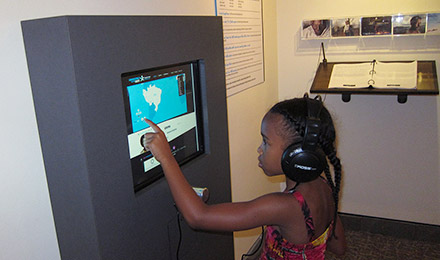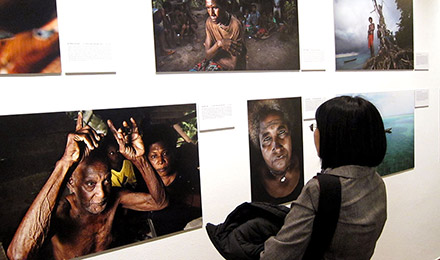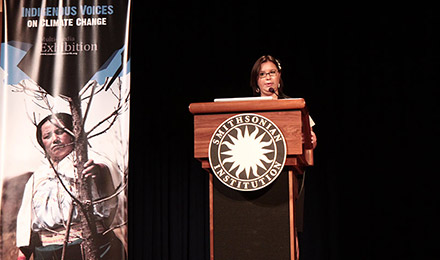Content
Conversation with the Earth artfully blends local knowledge of land and seascapes, media expertise, high-tech tools, and participatory action, to convey intimate stories of climate change. Through excellent reporting, powerful portraits, interviews, and participatory media, the visitor is immersed in the sounds and the feel of a site and its people. In the process the visitor experiences not only a story about climate change but the means by which the communities tell the story, and indeed the means by which indigenous communities everywhere share knowledge to address problems: a conversation.
Photography / and Talking portraits
 Over 120 photographs to recreate the experience of being live and in the field, CWE offers life-sized color portraits, and remote landscapes views.Select photographs allow the narrator to actually talk directly to the visitor via hidden MP3 sound boxes or other devices. The voice, usually field recordings in the original native language, is added either through a loudspeaker near the portrait or a stereo headphones by its side.
Over 120 photographs to recreate the experience of being live and in the field, CWE offers life-sized color portraits, and remote landscapes views.Select photographs allow the narrator to actually talk directly to the visitor via hidden MP3 sound boxes or other devices. The voice, usually field recordings in the original native language, is added either through a loudspeaker near the portrait or a stereo headphones by its side.
Participatory Video Booth
 Using video projectors or personal video stations, CWE screens over 30 films made by indigenous communities about their own experience with climate change, using the participatory video methodology. Cameras in their hands, community members interview their friends and neighbors, men and women, parents and children, youth and elders, to record how climate-change affects their daily lives. The result is a direct testimony, a skillful and custom-crafted narrative, and community-owned media. The 10-minute clips come from the growing Indigenous Media Hubs network that CWE is promoting around the world.
Using video projectors or personal video stations, CWE screens over 30 films made by indigenous communities about their own experience with climate change, using the participatory video methodology. Cameras in their hands, community members interview their friends and neighbors, men and women, parents and children, youth and elders, to record how climate-change affects their daily lives. The result is a direct testimony, a skillful and custom-crafted narrative, and community-owned media. The 10-minute clips come from the growing Indigenous Media Hubs network that CWE is promoting around the world.
Text panels and published work
 At the visual heart of the exhibit is a series of photo essays about local communities and the issues that affect them. Each photograph here offers an informative caption and/or a quote from field recordings, easing the visitor into a deeper understanding of each story displayed. These will be supplemented by informative text panels introducing each of the photo essays separately. In some cases, panels display fuller text or a published article on the story concerned.
At the visual heart of the exhibit is a series of photo essays about local communities and the issues that affect them. Each photograph here offers an informative caption and/or a quote from field recordings, easing the visitor into a deeper understanding of each story displayed. These will be supplemented by informative text panels introducing each of the photo essays separately. In some cases, panels display fuller text or a published article on the story concerned.
In-Person Testimonies
 One of the most powerful ways to experience the exhibit is when visitors can interact directly from local indigenous community members who appears in the photostories or have created the videos. Whenever it is possible, CWE facilitates the travel of local participants to CWE exhibits for special events and conferences where they can dialogue with the visitors.
One of the most powerful ways to experience the exhibit is when visitors can interact directly from local indigenous community members who appears in the photostories or have created the videos. Whenever it is possible, CWE facilitates the travel of local participants to CWE exhibits for special events and conferences where they can dialogue with the visitors.
Contemporary interpretations by traditional artisans
 CWE exhibit include contemporary indigenous artisan’s reflection on the meaning of climate change through original creations of traditional crafts.
CWE exhibit include contemporary indigenous artisan’s reflection on the meaning of climate change through original creations of traditional crafts.
Mobile exhibits

The exhibition
Conversations with the Earth: Indigenous Voices on Climate Change, has been on tour internationally in two formats: “
Full-scale” – mostly designed for longer term museum display; and
“Mobile” – a portable all-weather installation, easy to ship and install, ready to be displayed in communities, in schools, at conferences and special events, anywhere from a few hours to a few weeks.
 Over 120 photographs to recreate the experience of being live and in the field, CWE offers life-sized color portraits, and remote landscapes views.Select photographs allow the narrator to actually talk directly to the visitor via hidden MP3 sound boxes or other devices. The voice, usually field recordings in the original native language, is added either through a loudspeaker near the portrait or a stereo headphones by its side.
Over 120 photographs to recreate the experience of being live and in the field, CWE offers life-sized color portraits, and remote landscapes views.Select photographs allow the narrator to actually talk directly to the visitor via hidden MP3 sound boxes or other devices. The voice, usually field recordings in the original native language, is added either through a loudspeaker near the portrait or a stereo headphones by its side.
 Using video projectors or personal video stations, CWE screens over 30 films made by indigenous communities about their own experience with climate change, using the participatory video methodology. Cameras in their hands, community members interview their friends and neighbors, men and women, parents and children, youth and elders, to record how climate-change affects their daily lives. The result is a direct testimony, a skillful and custom-crafted narrative, and community-owned media. The 10-minute clips come from the growing Indigenous Media Hubs network that CWE is promoting around the world.
Using video projectors or personal video stations, CWE screens over 30 films made by indigenous communities about their own experience with climate change, using the participatory video methodology. Cameras in their hands, community members interview their friends and neighbors, men and women, parents and children, youth and elders, to record how climate-change affects their daily lives. The result is a direct testimony, a skillful and custom-crafted narrative, and community-owned media. The 10-minute clips come from the growing Indigenous Media Hubs network that CWE is promoting around the world.
 At the visual heart of the exhibit is a series of photo essays about local communities and the issues that affect them. Each photograph here offers an informative caption and/or a quote from field recordings, easing the visitor into a deeper understanding of each story displayed. These will be supplemented by informative text panels introducing each of the photo essays separately. In some cases, panels display fuller text or a published article on the story concerned.
At the visual heart of the exhibit is a series of photo essays about local communities and the issues that affect them. Each photograph here offers an informative caption and/or a quote from field recordings, easing the visitor into a deeper understanding of each story displayed. These will be supplemented by informative text panels introducing each of the photo essays separately. In some cases, panels display fuller text or a published article on the story concerned.
 One of the most powerful ways to experience the exhibit is when visitors can interact directly from local indigenous community members who appears in the photostories or have created the videos. Whenever it is possible, CWE facilitates the travel of local participants to CWE exhibits for special events and conferences where they can dialogue with the visitors.
One of the most powerful ways to experience the exhibit is when visitors can interact directly from local indigenous community members who appears in the photostories or have created the videos. Whenever it is possible, CWE facilitates the travel of local participants to CWE exhibits for special events and conferences where they can dialogue with the visitors.
 CWE exhibit include contemporary indigenous artisan’s reflection on the meaning of climate change through original creations of traditional crafts.
CWE exhibit include contemporary indigenous artisan’s reflection on the meaning of climate change through original creations of traditional crafts.
 The exhibition Conversations with the Earth: Indigenous Voices on Climate Change, has been on tour internationally in two formats: “Full-scale” – mostly designed for longer term museum display; and “Mobile” – a portable all-weather installation, easy to ship and install, ready to be displayed in communities, in schools, at conferences and special events, anywhere from a few hours to a few weeks.
The exhibition Conversations with the Earth: Indigenous Voices on Climate Change, has been on tour internationally in two formats: “Full-scale” – mostly designed for longer term museum display; and “Mobile” – a portable all-weather installation, easy to ship and install, ready to be displayed in communities, in schools, at conferences and special events, anywhere from a few hours to a few weeks.

